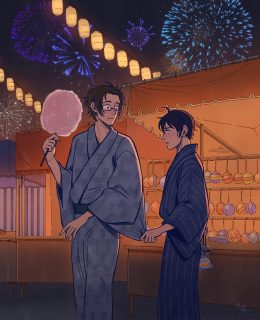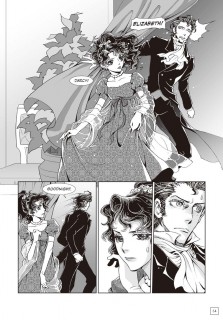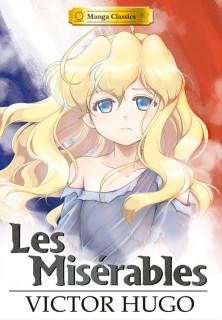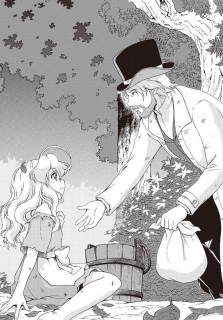My News and Reviews
Other than the usual My Week in Manga, I didn’t manage to post any other features at Experiments in Manga last week. This was largely expected since I’m still catching up from my trip to the Toronto Comic Arts Festival. I have, however, been working on writing up some of my random musings about this year’s festival and hope to have those ready to post within the next few days. There is one thing that happened last week that I’d definitely like to share with everyone, though: the artwork that I commissioned from KaiJu was finished!
The illustration is of the characters Sachi and Kadoyuki from Lianne Sentar’s Tokyo Demons, a series which I love very, very much. I’m also quite fond of KaiJu’s original work as well, some of which I’ve previously reviewed here at Experiments in Manga. The creative team’s current comic is Novae which is absolutely wonderful and well-worth checking out.
Elsewhere online: Lilian Min talks to Jane Mai and An Nguyen about their new book So Pretty / Very Rotten in the article The Complex Femininity of Japanese Lolita Fashion. One of Tofugu’s most recent podcasts, Interpreting for Osamu Tezuka, features Frederick L. Schodt. Also at Tofugu, manga translator Zack Davisson has some advice for learning Japanese. Speaking of Davisson, he’ll be translating two of Seven Sea’s recently announced acquisitions: Go Nagai’s original Devilman manga series (this is huge!) as well as Go Nagai and Team Moon’s Devilman vs. Hades manga. In other licensing news, Viz Media will be releasing Hinodeya Sankichi’s Splatoon manga.
Quick Takes
 Flying Witch, Volume 1 by Chihiro Ishizuka. I was only vaguely aware of Flying Witch before Vertical Comics licensed the manga; although I haven’t actually watched it, a twelve-episode anime adaptation of the series first aired a little over a year ago. Flying Witch is a manga about Makoto, a fifteen-year-old witch who has moved to the country to stay with her relatives while she completes her magic training. She’s a bit of an airhead and has a terrible sense of direction, but she’s earnest and kind and quick to make friends with the locals. The focus of Flying Witch is on the everyday lives of Makoto, her relatives, and friends. It’s a gentle and harmless manga that much of the time isn’t even about magic though it can still occasionally be charming. The manga’s artwork, much like the story itself, is functional but not particularly distinctive and even the worldbuilding is somewhat lacking. Flying Witch isn’t a bad series, but it didn’t really grab me, either. Granted, I don’t have a particular interest in witches. However, I did really like the series’ countryside setting. Additionally, The Harbinger of Spring, a nature spirit introduced in one of the final chapters of the first volume, was a fascinating addition and easily my favorite part of the manga.
Flying Witch, Volume 1 by Chihiro Ishizuka. I was only vaguely aware of Flying Witch before Vertical Comics licensed the manga; although I haven’t actually watched it, a twelve-episode anime adaptation of the series first aired a little over a year ago. Flying Witch is a manga about Makoto, a fifteen-year-old witch who has moved to the country to stay with her relatives while she completes her magic training. She’s a bit of an airhead and has a terrible sense of direction, but she’s earnest and kind and quick to make friends with the locals. The focus of Flying Witch is on the everyday lives of Makoto, her relatives, and friends. It’s a gentle and harmless manga that much of the time isn’t even about magic though it can still occasionally be charming. The manga’s artwork, much like the story itself, is functional but not particularly distinctive and even the worldbuilding is somewhat lacking. Flying Witch isn’t a bad series, but it didn’t really grab me, either. Granted, I don’t have a particular interest in witches. However, I did really like the series’ countryside setting. Additionally, The Harbinger of Spring, a nature spirit introduced in one of the final chapters of the first volume, was a fascinating addition and easily my favorite part of the manga.
 Jane Eyre adapted by Crystal Silvermoon Chan and illustrated by SunNeko Lee. Charlotte Brontë’s Jane Eyre holds a very special place in my heart; I first read it in high school and it remains one of my favorite novels. To varying degrees, I’ve enjoyed the numerous films, novels, comics, and other works inspired by Jane Eyre that I’ve encountered as well. And so I was very curious to read one of the most recent adaptations, Chan and Lee’s Jane Eyre comic from Udon Entertainment’s Manga Classics line. (This is the same creative team which worked on the adaptation of Victor Hugo’s Les Misérables, one of Manga Classics debut titles.) Though overall Lee’s artwork is attractive, I wasn’t entirely satisfied by the character designs of the leads–Jane as a young woman doesn’t look much older than when she was a child, and Mr. Rochester comes across as too traditionally handsome. Other than that relatively minor complaint, Chan and Lee’s Jane Eyre remains true to Brontë’s original and is an enjoyable and very accessible rendition. Some small changes have been made, as Chan describes in the essay about the adaptation process, but all the major characterization and plot points remain. The volume also includes additional historical background information. Now I really want to reread the novel again.
Jane Eyre adapted by Crystal Silvermoon Chan and illustrated by SunNeko Lee. Charlotte Brontë’s Jane Eyre holds a very special place in my heart; I first read it in high school and it remains one of my favorite novels. To varying degrees, I’ve enjoyed the numerous films, novels, comics, and other works inspired by Jane Eyre that I’ve encountered as well. And so I was very curious to read one of the most recent adaptations, Chan and Lee’s Jane Eyre comic from Udon Entertainment’s Manga Classics line. (This is the same creative team which worked on the adaptation of Victor Hugo’s Les Misérables, one of Manga Classics debut titles.) Though overall Lee’s artwork is attractive, I wasn’t entirely satisfied by the character designs of the leads–Jane as a young woman doesn’t look much older than when she was a child, and Mr. Rochester comes across as too traditionally handsome. Other than that relatively minor complaint, Chan and Lee’s Jane Eyre remains true to Brontë’s original and is an enjoyable and very accessible rendition. Some small changes have been made, as Chan describes in the essay about the adaptation process, but all the major characterization and plot points remain. The volume also includes additional historical background information. Now I really want to reread the novel again.
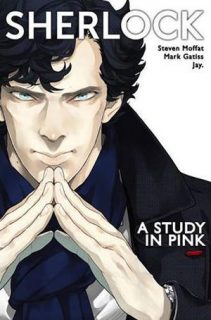 Sherlock, Volume 1: A Study in Pink by Jay. I believe Sherlock is the very first manga to be released by Titan Comics, recently followed by Yano Takashi and Kenji Oiwa’s Assassin’s Creed: Awakening. The fact that Titan isn’t a typical manga publisher and hasn’t released many manga may partly explain why Jay’s adaptation of the BBC’s television series Sherlock was first released in English as six individual comic issues before being collected into a single volume. Titan’s catalog largely consists of comic adaptations of Western television and video game franchises, so Jay’s Sherlock fits in nicely with the rest. Sherlock is a modern reimagining of Sir Arthur Conan Doyle’s Sherlock Holmes stories, A Study in Pink influenced heavily by Doyle’s novel A Study in Scarlet. It’s been a while since I’ve actually watched A Study in Pink, but Jay’s interpretation does seem to be a very faithful one, including character designs that are based on the show’s actors, most notably Benedict Cumberbatch (Sherlock) and Martin Freeman (Watson). Some of the action can be a little difficult to follow, but otherwise I largely enjoyed Jay’s version of A Study in Pink. However, because it is such a close adaptation and nothing much is added or taken away I’m not entirely sure who the best or intended audience for the Sherlock manga would be; most people would likely be satisfied with the original episode.
Sherlock, Volume 1: A Study in Pink by Jay. I believe Sherlock is the very first manga to be released by Titan Comics, recently followed by Yano Takashi and Kenji Oiwa’s Assassin’s Creed: Awakening. The fact that Titan isn’t a typical manga publisher and hasn’t released many manga may partly explain why Jay’s adaptation of the BBC’s television series Sherlock was first released in English as six individual comic issues before being collected into a single volume. Titan’s catalog largely consists of comic adaptations of Western television and video game franchises, so Jay’s Sherlock fits in nicely with the rest. Sherlock is a modern reimagining of Sir Arthur Conan Doyle’s Sherlock Holmes stories, A Study in Pink influenced heavily by Doyle’s novel A Study in Scarlet. It’s been a while since I’ve actually watched A Study in Pink, but Jay’s interpretation does seem to be a very faithful one, including character designs that are based on the show’s actors, most notably Benedict Cumberbatch (Sherlock) and Martin Freeman (Watson). Some of the action can be a little difficult to follow, but otherwise I largely enjoyed Jay’s version of A Study in Pink. However, because it is such a close adaptation and nothing much is added or taken away I’m not entirely sure who the best or intended audience for the Sherlock manga would be; most people would likely be satisfied with the original episode.
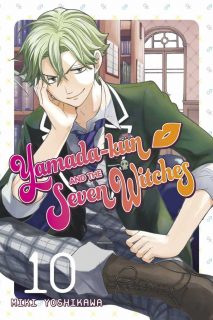 Yamada-kun and the Seven Witches, Volumes 10-12 by Miki Yoshikawa. From the beginning Yamada-kun and the Seven Witches wasn’t without its problems, but I thoroughly enjoyed the first part of the manga. However, I’m now starting to find the series somewhat wearisome even though there are some things that are quite well done and that I still like about it. With these three volumes, Yoshikawa brings the second major story arc of Yamada-kun and the Seven Witches to a close and begins yet another one. To the Yoshikawa’s credit, each time the story is more or less restarted it makes logical sense, but at this point it feels like the series is being stretched out far longer than it was originally intended. (I suspect that Yamada-kun and the Seven Witches may be a victim of its own popularity and success.) The first story arc was highly entertaining, but I wasn’t as impressed with the second and the third hasn’t instilled much confidence in me that it will greatly improve. On top of that, the manga’s fanservice has become more and more forced as the series has progressed. Where at one point it was incorporated well into the story, more recently the fanservice is haphazard at best. Because at first I did greatly enjoy Yamada-kun and the Seven Witches and appreciated its gender play and themes of friendship, it saddens me to see the series’ decline.
Yamada-kun and the Seven Witches, Volumes 10-12 by Miki Yoshikawa. From the beginning Yamada-kun and the Seven Witches wasn’t without its problems, but I thoroughly enjoyed the first part of the manga. However, I’m now starting to find the series somewhat wearisome even though there are some things that are quite well done and that I still like about it. With these three volumes, Yoshikawa brings the second major story arc of Yamada-kun and the Seven Witches to a close and begins yet another one. To the Yoshikawa’s credit, each time the story is more or less restarted it makes logical sense, but at this point it feels like the series is being stretched out far longer than it was originally intended. (I suspect that Yamada-kun and the Seven Witches may be a victim of its own popularity and success.) The first story arc was highly entertaining, but I wasn’t as impressed with the second and the third hasn’t instilled much confidence in me that it will greatly improve. On top of that, the manga’s fanservice has become more and more forced as the series has progressed. Where at one point it was incorporated well into the story, more recently the fanservice is haphazard at best. Because at first I did greatly enjoy Yamada-kun and the Seven Witches and appreciated its gender play and themes of friendship, it saddens me to see the series’ decline.

